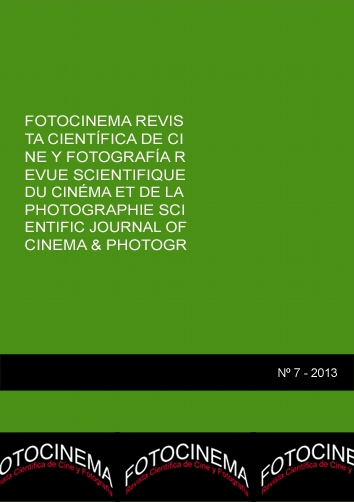La fotografía de moda en el cine: Funny face y Blow up
DOI:
https://doi.org/10.24310/Fotocinema.2013.v0i7.5927Abstract
El cine, la televisión y la fotografía de moda – unida esta última a dos fenómenos económicos y sociales característicos del siglo XX: la moda y la publicidad- contribuyeron decisivamente al creciente proceso de democratización y globalización de la incipiente sociedad de masas que culminó en una nueva concepción de la cultura, la cultura popular. La fotografía de moda y el cine fueron medios de difusión de los modos de vida y tendencias sociales de su tiempo. Esta reproductibilidad fotográfica y cinematográfica influyó notablemente en una nueva forma de entender las obras de arte y, lo más importante, modificó también nuestra forma de percibir imágenes. En este artículo analizamos el lenguaje de las imágenes de fotografía de moda que exponen dos películas que consideramos representativas: Funny Face, de Stanley Donen y Blow Up, de Michelangelo Antonioni, realizadas en las décadas de los cincuenta y sesenta del pasado siglo respectivamente.
ABSTRACT
Film, television and fashion photography –joined the later to the two distinctive economic and social phenomena of the twentieth century: fashion and advertising- contributed decisively to the growing process of democratization and globalization of the emerging mass society which culminated in a new conception of culture: popular culture. Fashion photography and film media were lifestyles and social trends of this time. This photographic and film reproducibility greatly influenced a new way of understanding art and, most importantly, also changed the way we perceive images. In this paper, we analyze the language of fashion photography images displayed in two films: Funny Face, by Stanley Donen and Blow Up, by Michelangelo Antonioni; made in the decades of the fifties and sixties of last century respectively.
PALABRAS CLAVES: Cine; Fotografía de moda; Funny Face; Blow Up; Cultura Pop.
KEY WORDS: Film; Fashion photography; Funny Face; Blow Up; Pop culture.Downloads
Metrics
Downloads
Published
How to Cite
Issue
Section
License
All contents published in Fotocinema Revista científica de cine y fotografía are protected under the Creative Commons Attribution-NonCommercial-ShareAlike 4.0 International (CC BY-NC-SA 4.0) license. All about this license is available in the following link: <http://creativecommons.org/licenses/by-nc-sa/4.0>
Users can copy, use, redistribute, share and exhibit publicly as long as:
- The original source and authorship of the material are cited (Journal, Publisher and URL of the work).
- It is not used for comercial purposes.
- The existence of the license and its especifications are mentioned.
There are two sets of authors’ rights: moral and property rights. Moral rights are perpetual prerogatives, unrenounceable, not-transferable, unalienable, imprescriptible and inembargable. According to authors’ rights legislation, Fotocinema. Revista científica de cine y fotografía recognizes and respects authors moral rights, as well as the ownership of property rights, which will be transferred to University of Malaga in open access. The property rights are referred to the benefits that are gained by the use or the dissemination of works. Fotocinema. Revista científica de cine y fotografía is published in an open access form and it is exclusively licenced by any means for doing or authorising distribution, dissemination, reproduction, , adaptation, translation or arrangement of works.
Authors are responsable for obtaining the necessary permission to use copyrighted images.













13.png)




